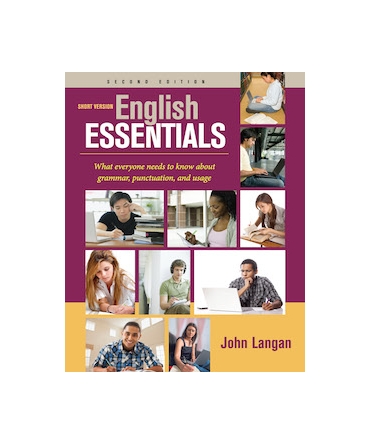English Essentials, Short Version, 2/e (book only)

Overview
English Essentials, Short Version, 2/e provides the clear guidance students need to help master key grammar, punctuation, and usage skills, as well as to understand the basics of effective writing. Get a brochure here.
More information
About the Book
Several features make this book different from other grammar texts on the market:
1 Ease of Use.
• Part One focuses on fourteen grammar and punctuation skills that students most need to write well. Once students master the basics, they can go on to Part Two, which includes secondary information about a number of skills. The materials in Parts Three and Four may be introduced at any time during the course. It is better to learn a step at a time than to risk confusion by trying to learn everything at once. For example, dependent-word fragments are the subject of one chapter; other common types of fragments appear in a second chapter. The most common homonyms are covered in Part One; other homonyms follow in a “More about Homonyms” section in Part Two.
• Each skill is explained in a one-page review that students can read and understand fairly quickly. Once they have grasped this basic material, they can go on to learn more about the skill and practice using the skill.
• Explanations are written in simple, familiar language, with a real emphasis on clarity and a minimum of grammatical terminology.
• The book is written in a friendly and helpful tone of voice—one that never condescends to students, but instead treats them as adults.
2 Abundant practice.
The book is based on the assumption that students learn best when clear explanations are followed by abundant practice. For each chapter in Part One, there is a practice activity followed by four full-page tests. The last two tests are designed to resemble standardized tests and permit easy grading.
3 Engaging materials.
Lively and engaging examples and practice materials will help maintain student interest throughout the book.
4 Reasonable price.
The low cost of the book makes it an attractive consumable. It can be be given outright to students for marking up, writing answers, tearing out pages, and the like. Teachers will no longer have to spend valuable time preparing handouts for use in class.
5 Free instructor supplements.
• A printed Instructor's Edition, identical to the student copy but featuring answers to all items in the text, is available to educators who adopt the text for class.
• An electronic Instructor’s Manual and Test Bank that includes teaching hints, diagnostic and achievement tests, a full answer key, and a bank of additional mastery tests is available to educators in the supplements page on the Learning Center.
In short, English Essentials is designed as a core worktext that will both engage the interest of today’s students and help them truly master the skills they need for writing well.
Changes in the Second Edition
A new Part Three. This section begins with a chapter on the basics of writing, followed by twenty writing assignments, some with sample student paragraphs. It also includes a chapter on proofreading techniques as well as ten proofreading tests.
An expanded Part Four. This section now contains material on spelling tips along with dictionary use and parts of speech.
Revised and updated practice sentences and tests. Content throughout Parts One and Two of the book has been refreshed, including more than one hundred new practice items.
Optional expanded online materials. English Essentials, Short Version, 2/e can be purchased with English Essentials Plus. This suite of electronic materials in our Learning Center includes new practice exercises and mastery tests as well as a complete eBook of the text.
To the Instructor
To the Student
PART ONE Fourteen Basic Skills
1 Subjects and Verbs
2 Irregular Verbs
3 Subject-Verb Agreement
4 Sentence Types
5 Fragments I
6 Fragments II
7 Run-Ons and Comma Splices I
8 Run-Ons and Comma Splices II
9 Commas
10 Apostrophes
11 Quotation Marks
12 Homonyms
13 Capital Letters
14 Parallelism
PART TWO Extending the Skills
15 Preparing a Paper
16 Punctuation Marks
17 Pronoun Forms
18 Pronoun Problems
19 Adjectives and Adverbs
20 Misplaced and Dangling Modifiers
21 Word Choice
22 Numbers and Abbreviations
23 More about Subjects and Verbs
24 More about Subject-Verb Agreement
25 More about Verbs: Tenses
26 Even More about Verbs
27 More about Run-Ons and Comma Splices
28 More about Commas
29 More about Apostrophes
30 More about Quotation Marks
31 More about Homonyms
32 More about Capital Letters
PART THREE Writing and Proofreading
33 The Basics of Writing
34 Writing Assignments
35 Proofreading Techniques
36 Ten Proofreading Tests
PART FOUR For Reference
37 Parts of Speech
38 Dictionary Use
39 Spelling Tips
